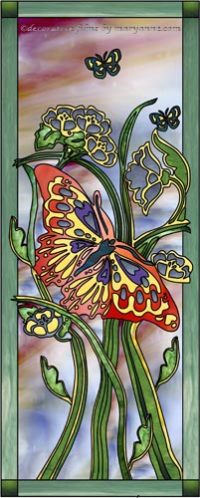Stained glass windows have long been a mesmerizing feature in architecture, capturing light in brilliant colors and intricate designs. Among the various styles that have emerged throughout history, Victorian stained glass stands out for its unique blend of elegance, complexity, and symbolism. This article delves into the enchanting world of Victorian stained glass window patterns and murals for windows, exploring their history, design elements, techniques, and enduring appeal.
Historical Background
The Victorian era, spanning from 1837 to 1901 during Queen Victoria’s reign, was a period of immense cultural, industrial, and artistic transformation. This era witnessed a resurgence of interest in medieval art and craftsmanship, driven by the Gothic Revival movement. Stained glass, a prominent feature of medieval cathedrals, experienced a revival during this time, becoming a popular choice for both ecclesiastical and secular buildings.
The Craft of Stained Glass
Materials and Techniques
Stained glass is created by adding metallic salts during its manufacture, which gives the glass its various hues. The process involves cutting pieces of colored glass to fit a specific design and joining them together with lead cames. Artists would often paint details onto the glass using vitreous paint, which is then fired in a kiln to fuse the paint with the glass.
Evolution of Victorian Stained Glass
Victorian stained glass evolved from the more straightforward geometric designs of earlier periods to incorporate complex patterns, rich colors, and detailed imagery. The industrial revolution played a crucial role in this evolution, as advancements in glass production and metalwork allowed for more elaborate and larger windows.
Victorian Stained Glass Window Patterns
Floral and Natural Themes
One of the most iconic features of Victorian stained glass window patterns is the use of floral and natural themes. Flowers such as roses, lilies, and sunflowers were commonly depicted, symbolizing purity, love, and growth. These floral motifs were often arranged in symmetrical patterns, creating a harmonious and balanced aesthetic.
Geometric Designs
Geometric patterns were also prevalent in Victorian stained glass, featuring intricate arrangements of shapes such as diamonds, squares, and circles. These designs were often used in border patterns and as backgrounds for more detailed scenes. The symmetry and repetition in these patterns reflect the Victorian fascination with order and precision.
Symbolic Imagery
Victorian stained glass often included symbolic imagery, drawing from Christian iconography, mythology, and heraldry. Angels, saints, and biblical scenes were frequently depicted in church windows, while secular buildings might feature mythical creatures, family crests, and allegorical figures representing virtues like justice and wisdom.
Murals for Windows
Narrative Scenes
Murals for windows, or large-scale stained glass compositions, became increasingly popular during the Victorian era. These murals often depicted narrative scenes, telling stories through a series of panels. In churches, these narratives were typically drawn from the Bible, such as the life of Christ, the apostles, or parables. In secular settings, historical events, literary works, and allegorical tales were common subjects.
Portraiture
Portraits in stained glass were another significant aspect of Victorian window murals. These could range from depictions of historical and religious figures to patrons who commissioned the windows. The portraits were rendered with remarkable detail, showcasing the skill of the artists in capturing facial expressions and attire.
Decorative Borders and Backgrounds
The use of decorative borders and backgrounds in stained glass murals added depth and context to the main scenes. Borders often featured repeating floral or geometric patterns, while backgrounds might include intricate landscapes, architecture, or abstract designs. These elements not only framed the central images but also enhanced the overall visual impact of the window.
Techniques and Innovations
Opalescent Glass
One of the notable innovations in Victorian stained glass was the use of opalescent glass, which was developed by American artist John La Farge and later popularized by Louis Comfort Tiffany. This type of glass has a milky, iridescent quality that adds a subtle glow and depth to the windows. Opalescent glass allowed for a greater range of colors and textures, enriching the visual complexity of the designs.
Etching and Sandblasting
Etching and sandblasting techniques were used to add fine details to stained glass. By selectively removing layers of glass, artists could create intricate patterns and shading, enhancing the realism of the imagery. These techniques were particularly useful for adding texture to backgrounds and fine details to figures and objects.
The Role of Stained Glass in Victorian Architecture
Churches and Cathedrals
Victorian stained glass windows were a defining feature of many churches and cathedrals built during this period. They were used not only to beautify the buildings but also to educate and inspire worshippers. The windows served as visual sermons, illustrating biblical stories and moral lessons in a vibrant and accessible way.
Secular Buildings
Stained glass was also widely used in secular Victorian architecture, including homes, public buildings, and commercial establishments. In homes, stained glass windows were often found in entryways, transoms, and staircases, adding a touch of elegance and color to the interiors. Public buildings like libraries, town halls, and schools used stained glass to convey civic pride and cultural values.
Preservation and Restoration
Challenges of Preservation
Preserving Victorian stained glass poses several challenges due to the delicate nature of the materials and the impact of environmental factors. Exposure to weather, pollution, and UV light can cause glass to fade, crack, or corrode over time. Lead cames can also deteriorate, leading to structural instability.
Restoration Techniques
Restoration of stained glass windows involves careful cleaning, repairing damaged glass, and replacing deteriorated lead cames. Modern conservation techniques aim to preserve as much of the original material as possible while ensuring the structural integrity of the window. This often involves collaboration between conservators, historians, and craftsmen to achieve an authentic restoration.
The Enduring Appeal of Victorian Stained Glass
Aesthetic and Artistic Value
The aesthetic and artistic value of Victorian stained glass continues to captivate people today. The intricate patterns, vibrant colors, and detailed imagery create a sense of wonder and admiration. Each window is a testament to the skill and creativity of the artists who crafted it, offering a glimpse into the artistic and cultural heritage of the Victorian era.
Symbolic and Emotional Resonance
Beyond their visual beauty, Victorian stained glass windows hold symbolic and emotional resonance. They connect us to the past, evoking memories of historical events, religious traditions, and personal stories. The symbolism embedded in the designs can inspire reflection and contemplation, adding a deeper dimension to the experience of viewing these windows.
Conclusion
Victorian stained glass window patterns and murals for windows represent a unique and enduring art form that combines beauty, craftsmanship, and symbolism. From the delicate floral motifs to the grand narrative scenes, these windows offer a rich visual and historical experience. Whether in a grand cathedral or a humble home, Victorian stained glass continues to illuminate our spaces and our imaginations, reminding us of the timeless allure of light and color.




